Impacts of Climate Change and Human Activities on Vegetation Productivity in China
Abstract
1. Introduction
2. Materials and Methods
2.1. Study Area
2.2. Data Sources
2.3. Methods
2.3.1. Calculation of LDCI
2.3.2. Land Use Transfer Matrix in Woodlands, Grasslands, and Croplands
2.3.3. Contributions of Climate Change and Human Activities to NPP
2.4. Statistical Analysis
3. Results
3.1. Spatiotemporal Patterns of NPP in Woodlands, Grasslands, and Croplands
3.2. Response of NPP to Climate Change and Human Activities
3.2.1. Effects of Climate Factors on NPP in Woodlands, Grasslands, and Croplands
3.2.2. Effects of Human Activities on NPP in Woodlands, Grasslands, and Croplands
3.3. Contributions of Climate Change and Human Activities on NPP
3.3.1. Actual Contributions of Climate Change and Human Activities to NPP
3.3.2. Relative Contributions of Climate Change and Human Activities to NPP
4. Discussion
4.1. Variation in NPP in Different Land Cover Types
4.2. Effects of Climate Change on NPP in Different Land Cover Types
4.3. Effects of Human Activities on NPP Variation in Different Land Cover Types
4.4. Limitations and Uncertainty
5. Conclusions
Author Contributions
Funding
Data Availability Statement
Acknowledgments
Conflicts of Interest
References
- Ji, Y.; Zhou, G.; Luo, T.; Dan, Y.; Zhou, L.; Lv, X. Variation of net primary productivity and its drivers in China’s forests during 2000–2018. For. Ecosyst. 2020, 7, 1–11. [Google Scholar] [CrossRef]
- Riva, F.; Martin, C.J.; Millard, K.; Fahrig, L. Loss of the world’s smallest forests. Glob. Change Biol. 2022, 28, 7164–7166. [Google Scholar] [CrossRef] [PubMed]
- Dixon, R.K.; Brown, S.; Houghton, R.A.; Trexier, M.C.; Wisniewski, J. Carbon pools and flux of global forest ecosystems. Science 1994, 263, 185–190. [Google Scholar] [CrossRef] [PubMed]
- Zhang, H.; Wang, K.; Zeng, Z.; Du, H.; Zou, Z.; Xu, Y.; Zeng, F. Large-scale patterns in forest growth rates are mainly driven by climatic variables and stand characteristics. For. Ecol. Manag. 2019, 435, 120–127. [Google Scholar] [CrossRef]
- Zhou, G.; Wang, Y.; Jiang, Y.; Yang, Z. Estimating biomass and net primary production from forest inventory data: A case study of China’s Larix forests. For. Ecol. Manag. 2002, 169, 149–157. [Google Scholar] [CrossRef]
- Yao, Y.; Piao, S.; Wang, T. Future biomass carbon sequestration capacity of Chinese forests. Sci. Bull. 2018, 63, 1108–1117. [Google Scholar] [CrossRef]
- Liu, Y.; Yang, Y.; Wang, Q.; Du, X.; Li, J.; Gang, C.; Zhou, W.; Wang, Z. Evaluating the responses of net primary productivity and carbon use efficiency of global grassland to climate variability along an aridity gradient. Sci. Total Environ. 2019, 652, 671–682. [Google Scholar] [CrossRef]
- Liu, X.; Xu, Y.Y.; Sun, S.K.; Zhao, X.N.; Wu, P.T.; Wang, Y.B. What is the potential to improve food security by restructuring crops in Northwest China? J. Clean. Prod. 2022, 378, 134620. [Google Scholar] [CrossRef]
- Zhou, W.; Yang, H.; Zhou, L.; Chen, Y.; Huang, L.; Ju, W. Dynamics of grassland carbon sequestration and its coupling relation with hydrothermal factor of Inner Mongolia. Ecol. Indic. 2018, 95, 1–11. [Google Scholar] [CrossRef]
- Liu, Y.; Zhou, R.; Ren, H.; Zhang, W.; Zhang, Z.; Zhang, Z.; Wen, Z. Evaluating the dynamics of grassland net primary productivity in response to climate change in China. Glob. Ecol. Conserv. 2021, 28, e01574. [Google Scholar] [CrossRef]
- Maestrini, B.; Mimić, G.; van Oort, P.A.; Jindo, K.; Brdar, S.; Athanasiadis, I.N.; van Evert, F.K. Mixing process-based and data-driven approaches in yield prediction. Eur. J. Agron. 2022, 139, 126569. [Google Scholar] [CrossRef]
- Tao, F.L.; Palosuo, T.; Valkama, E.; Makipaa, R. Cropland soils in China have a large potential for carbon sequestration based it on literature survey. Soil Till. Res. 2019, 186, 70–78. [Google Scholar] [CrossRef]
- Ortiz-Bobea, A.; Ault, T.R.; Carrillo, C.M.; Chambers, R.G.; Lobell, D.B. Anthropogenic climate change has slowed global agricultural productivity growth. Nat. Clim. Change 2021, 11, 306–312. [Google Scholar] [CrossRef]
- Intergovernmental Panel on Climate Change. Sixth Assessment Report. 2022. Available online: https://www.ipcc.ch/assessment-report/ar6/ (accessed on 24 July 2024).
- Walther, G.R.; Post, E.; Convey, P.; Menzel, A.; Parmesan, C.; Beebee, T.J.C.; Fromentin, J.M.; Hoegh, G.O.; Bairlein, F. Ecological responses to recent climate change. Nature 2002, 416, 389–395. [Google Scholar] [CrossRef]
- Li, H.; Sun, B.; Wang, H.; Zhou, B.; Ma, X. Characteristics and mechanisms of the severe compound cold-wet event in southern China during February 2022. Environ. Res. Lett. 2023, 18, 114021. [Google Scholar] [CrossRef]
- Parra, A.; Greenberg, J. Climate-limited vegetation change in the conterminous United States of America. Glob. Change Biol. 2024, 30, e17204. [Google Scholar] [CrossRef]
- Rüger, N.; Condit, R.; Dent, D.H.; DeWalt, S.J.; Hubbell, S.P.; Lichstein, J.W.; Lopez, O.R.; Wirth, C.; Farrior, C.E. Demographic trade-offs predict tropical forest dynamics. Science 2020, 368, 165. [Google Scholar] [CrossRef]
- Huang, Y.; Huang, L.; Qiu, C.J.; Ciais, P. Evaluation of effects of heat released from SOC decomposition on soil carbon stock and temperature. Glob. Change Biol. 2024, 30, e17391. [Google Scholar] [CrossRef]
- Xu, X.; Jiang, H.; Guan, M.; Wang, L.; Huang, Y.; Jiang, Y.; Wang, A. Vegetation responses to extreme climatic indices in coastal China from 1986 to 2015. Sci. Total Environ. 2020, 744, 140784. [Google Scholar] [CrossRef]
- Piedallu, C.; Chéret, V.; Denux, J.P.; Perez, V.; Azcona, J.S.; Seynave, I.; Gégout, J.C. Soil and climate differently impact NDVI patterns according to the season and the stand type. Sci. Total Environ. 2019, 651, 2874–2885. [Google Scholar] [CrossRef]
- Kazanski, C.E.; Cowles, J.; Dymond, S.; Clark, A.T.; David, A.S.; Jungers, J.M.; Kendig, A.E.; Riggs, C.E.; Trost, J.; Wei, X.J. Water availability modifies productivity response to biodiversity and nitrogen in long-term grassland experiments. Ecol. Appl. 2021, 31, e02363. [Google Scholar] [CrossRef] [PubMed]
- Wu, N.; Liu, A.; Ye, R.; Yu, D.; Du, W.; Chaolumeng, Q.; Liu, G.; Yu, S. Quantitative analysis of relative impacts of climate change and human activities on Xilingol grassland in recent 40 years. Glob. Ecol. Conserv. 2021, 32, e01884. [Google Scholar] [CrossRef]
- Sun, J.; Yan, Y.; Zhang, B.; Liu, W.; Dou, S.; Wang, X.; Huang, J.; Chen, D.; Wang, C.; Han, X.; et al. Changes in productivity partitioning induced by precipitation extremes increase inaccuracy of grassland carbon estimation. Glob. Change Biol. 2024, 30, e17404. [Google Scholar] [CrossRef] [PubMed]
- Wang, X.; Wang, C.; Wu, J.; Miao, G.; Chen, M.; Chen, S.; Wang, S.; Guo, Z.; Wang, Z.; Wang, B.; et al. Intermediate Aerosol Loading Enhances Photosynthetic Activity of Croplands. Geophys. Res. Lett. 2021, 48, e2020GL091893. [Google Scholar] [CrossRef]
- Zhao, M.; Cao, L. Regional response of land hydrology and carbon uptake to different amounts of solar radiation modification. Earth’s Future 2022, 10, e2022EF003288. [Google Scholar] [CrossRef]
- Yu, T.; Jiapaer, G.L.; Long, G.; Li, X.; Jing, J.Y.; Liu, Y.; De Maeyer, P.; Van de Voorde, T. Interannual and seasonal relationships between photosynthesis and summer soil moisture in the Ili River basin, Xinjiang, 2000–2018. Sci. Total Environ. 2023, 856, 159191. [Google Scholar] [CrossRef]
- Yoo, C.; Na, W.; Chang, K.H.; Song, S.K. Ecohydrological investigation of cloud seeding effect on vegetation activity in the Boryeong Dam Basin, South Korea. Sci. Total Environ. 2024, 940, 173598. [Google Scholar] [CrossRef]
- De, J.R.; Schaepman, M.E.; Furrer, R.; De, B.S.; Verburg, P.H. Spatial relationship between climatologies and changes in global vegetation activity. Glob. Change Biol. 2013, 19, 1953–1964. [Google Scholar]
- Tong, X.; Brandt, M.; Yue, Y.; Ciais, P.; Jepsen, M.; Penuelas, J.; Wigneron, J.P.; Xiao, X.; Song, X.P.; Horion, S.; et al. Forest management in Southern China generates short term extensive carbon sequestration. Nat. Commun. 2020, 11, 129. [Google Scholar] [CrossRef]
- Chen, C.; Park, T.; Wang, X.H.; Piao, S.L.; Xu, B.D.; Chaturvedi, R.K.; Fuchs, R.; Brovkin, V.; Ciais, P.; Fensholt, R.; et al. China and India lead in greening of the world through land-use management. Nat. Sustain. 2019, 2, 122–129. [Google Scholar] [CrossRef]
- Liu, J.G.; Li, S.X.; Ouyang, Z.Y.; Tam, C.; Chen, X.D. Ecological and socioeconomic effects of China’s policies for ecosystem services. Proc. Natl. Acad. Sci. USA 2008, 105, 9477–9482. [Google Scholar] [CrossRef] [PubMed]
- Chen, Y.Z.; Feng, X.M.; Tian, H.Q.; Wu, X.T.; Gao, Z.; Feng, Y.; Piao, S.L.; Lv, N.; Pan, N.Q.; Fu, B.J. Accelerated increase in vegetation carbon sequestration in China after 2010: A turning point resulting from climate and human interaction. Glob. Change Biol. 2021, 27, 5848–5864. [Google Scholar] [CrossRef] [PubMed]
- Cao, S.X.; Xia, C.Q.; Xian, J.L.; Guo, H.; Zheng, H.R. Payoff of the grain for green policy. J. Appl. Ecol. 2020, 57, 1180–1188. [Google Scholar] [CrossRef]
- Sun, B.; Li, Z.Y.; Gao, W.T.; Zhang, Y.Y.; Gao, Z.H.; Song, Z.L.; Qin, P.Y.; Tian, X. Identification and assessment of the factors driving vegetation degradation/regeneration in drylands using synthetic high spatiotemporal remote sensing Data-A case study in Zhenglanqi, Inner Mongolia China. Ecol. Indic. 2019, 107, 105614. [Google Scholar] [CrossRef]
- Shen, F.; Yang, L.; Zhang, L.; Guo, M.; Huang, H.; Zhou, C. Quantifying the direct effects of long-term dynamic land use intensity on vegetation change and its interacted effects with economic development and climate change in jiangsu, China. J. Environ. Manag. 2023, 325, 116562. [Google Scholar] [CrossRef]
- Ma, M.; Wang, Q.; Liu, R.; Zhao, Y.; Zhang, D. Effects of climate change and human activities on vegetation coverage change in northern China considering extreme climate and time-lag and -accumulation effects. Sci. Total Environ. 2023, 860, 160527. [Google Scholar] [CrossRef]
- Xie, S.; Mo, X.; Hu, S.; Liu, S. Contributions of climate change, elevated atmospheric CO2 and human activities to ET and GPP trends in the Three-North Region of China. Agric. For. Meteorol. 2020, 295, 108183. [Google Scholar] [CrossRef]
- Ge, W.; Deng, L.; Wang, F.; Han, J. Quantifying the contributions of human activities and climate change to vegetation net primary productivity dynamics in China from 2001 to 2016. Sci. Total Environ. 2021, 773, 145648. [Google Scholar] [CrossRef]
- Gao, W.; Zheng, C.; Liu, X.; Lu, Y.; Chen, Y.; Wei, Y.; Ma, Y. NDVI-based vegetation dynamics and their responses to climate change and human activities from1982 to 2020: A case study in the Mu Us Sandy Land, China. Ecol. Indic. 2022, 137, 108745. [Google Scholar] [CrossRef]
- Peng, S. 1-km Monthly Mean Temperature Dataset for China (1901–2023); National Tibetan Plateau/Third Pole Environment Data Center: Beijing, China, 2019. [Google Scholar]
- Peng, S. 1-km Monthly Precipitation Dataset for China (1901–2023); National Tibetan Plateau/Third Pole Environment Data Center: Beijing, China, 2020. [Google Scholar]
- Shangguan, W.; Li, Q.; Shi, G. A 1 km Daily Soil Moisture Dataset over China Based on In-Situ Measurement (2000–2022); National Tibetan Plateau/Third Pole Environment Data Center: Beijing, China, 2022. [Google Scholar]
- Yang, J.; Huang, X. The 30 m annual land cover datasets and its dynamics in China from 1985 to 2022. Earth Syst. Sci. Data 2023, 13, 3907–3925. [Google Scholar] [CrossRef]
- Zhang, X.; Yue, Y.; Tong, X.; Wang, K.; Qi, X.; Deng, C.; Brandt, M. Eco-engineering controls vegetation trends in southwest China karst. Sci. Total Environ. 2021, 770, 145160. [Google Scholar] [CrossRef] [PubMed]
- Li, H.; Wu, Y.; Liu, S.; Xiao, J. Regional contributions to interannual variability of net primary production and climatic attributions. Agric. For. Meteorol. 2021, 303, 108384. [Google Scholar] [CrossRef]
- Wang, X.; Tan, K.; Chen, B.Z.; Du, P.J. Assessing the spatiotemporal variation and impact factors of net primary productivity in China. Sci. Rep. 2017, 7, 44415. [Google Scholar] [CrossRef] [PubMed]
- FAO. Global Forest Resources Assessment 2020: Key Findings; FAO: Rome, Italy, 2020. [Google Scholar]
- Qiu, Z.; Feng, Z.; Song, Y.; Li, M.; Zhang, P. Carbon sequestration potential of forest vegetation in China from 2003 to 2050: Predicting forest vegetation growth based on climate and the environment. J. Clean. Prod. 2020, 252, 119715. [Google Scholar] [CrossRef]
- Gao, J.; Ji, Y.; Zhang, X. Net primary productivity exhibits a stronger climatic response in planted versus natural forests. Ecol. Manag. 2023, 529, 120722. [Google Scholar] [CrossRef]
- Liu, Y.; Yang, P.; Zhang, Z.; Zhang, W.; Wang, Z.; Zhang, Z.; Ren, H.; Zhou, R.; Wen, Z.; Hu, T. Diverse responses of grassland dynamics to climatic and anthropogenic factors across the different time scale in China. Ecol. Indic. 2021, 132, 108341. [Google Scholar] [CrossRef]
- Zhang, M.; Zhang, F.; Guo, L.; Dong, P.; Cheng, C.; Kumar, P.; Johnson, B.A.; Chan, N.W.; Shi, J. Contributions of climate change and human activities to grassland degradation and improvement from 2001 to 2020 in Zhaosu County. China. J. Environ. Manag. 2023, 348, 119465. [Google Scholar] [CrossRef]
- Zhou, W.; Yang, H.; Huang, L.; Chen, C.; Lin, X.; Hu, Z.; Li, J. Grassland degradation remote sensing monitoring and driving factors quantitative assessment in China from 1982 to 2010. Ecol. Indic. 2017, 83, 303–313. [Google Scholar] [CrossRef]
- Liu, Y.; Jun, Z.; Zhang, C.; Xiao, B.; Liu, L.; Cao, Y. Spatial and temporal variations of vegetation net primary productivity and its responses to climate change in Shandong Province from 2000 to 2015. Chin. J. Ecol. 2019, 690, 27–39. [Google Scholar]
- Smith, W.K.; Cleveland, C.C.; Reed, S.C.; Running, S.W. Agricultural conversion without external water and nutrient inputs reduces terrestrial vegetation productivity. Geopyhs. Res. Lett. 2014, 41, 449–455. [Google Scholar] [CrossRef]
- Liu, Y.Q.; Song, W.; Deng, X.Z. Changes in crop type distribution in Zhangye City of the Heihe River Basin, China. Appl. Geogr. 2016, 76, 22–36. [Google Scholar] [CrossRef]
- Xiao, X.; Li, X.; Jiang, T.; Tan, M.; Hu, M.; Liu, Y.; Zeng, W. Response of net primary production to land use and climate changes in the middle-reaches of the Heihe River basin. Ecol. Evol. 2019, 9, 4651–4666. [Google Scholar] [CrossRef] [PubMed]
- Haberl, H.; Erb, K.H.; Krausmann, F.; Gaube, V.; Bondeau, A.; Plutzar, C.; Gingrich, S.; Lucht, W.; Fischer-Kowalski, M. Quantifying and mapping the human appropriation of net primary production in earth’s terrestrial ecosystems. Proc. Natl. Acad. Sci. USA 2007, 104, 12942–12947. [Google Scholar] [CrossRef] [PubMed]
- Ji, X.; Thompson, A.; Lin, J.S.; Jiang, F.S.; Ge, H.L.; Yu, M.M.; Huang, Y.H. Modeling spatial distribution of rainfall infiltration amounts in South China using cellular automata and its relationship with the occurrence of collapsing gullies. Catena 2020, 194, 104676. [Google Scholar] [CrossRef]
- Zhang, X.; Zhao, W.; Wang, L.; Liu, Y.; Liu, Y.; Feng, Q. Relationship between soil water content and soil particle size on typical slopes of the Loess Plateau during a drought year. Sci. Total Environ. 2019, 648, 943–954. [Google Scholar] [CrossRef]
- Zhang, J.; Duan, L.; Liu, T.; Chen, Z.; Wang, Y.; Li, M.; Zhou, Y. Experimental analysis of soil moisture response to rainfall in a typical grassland hillslope under different vegetation treatments. Environ. Res. 2022, 213, 113608. [Google Scholar] [CrossRef]
- Shi, P.; Li, P.; Li, Z.N.; Sun, J.M.; Wang, D.J.; Min, Z.Q. Effects of grass vegetation coverage and position on runoff and sediment yields on the slope of Loess Plateau, China. Agric. Water Manag. 2021, 259, 107231. [Google Scholar] [CrossRef]
- Sun, W.; Zhao, X.; Gao, X.; Shi, W.; Ling, Q.; Siddique, K.H.M. Impacts of land use conversion on the response of soil respiration to precipitation in drylands: A case study with four-yearlong observations. Agric. For. Meteorol. 2021, 304–305, 108426. [Google Scholar] [CrossRef]
- Ahlström, A.; Raupach, M.R.; Schurgers, G.; Smith, B.; Arneth, A.; Jung, M.; Reichstein, M.; Canadell, J.G.; Friedlingstein, P.; Jain, A.K.; et al. The Dominant Role of Semi-Arid Ecosystems in the Trend and Variability of the Land CO2 Sink. Science 2015, 348, 895–899. [Google Scholar] [CrossRef]
- Jiang, Y.; Hou, W.J.; Gao, J.B.; Wu, S.H. Refined revealing the chain path of multiple ecosystem services under diverse environmental factor gradients. Sci. Total Environ. 2023, 865, 161187. [Google Scholar] [CrossRef]
- Yuan, W.; Zheng, Y.; Piao, S.; Ciais, P.; Lombardozzi, D.; Wang, Y.; Ryu, Y.; Chen, G.; Dong, W.; Hu, Z.; et al. Increased atmospheric vapor pressure deficit reduces global vegetation growth. Sci. Adv. 2019, 5, eaax1396. [Google Scholar] [CrossRef] [PubMed]
- Hou, Q.Q.; Yang, H.; Wu, J.S.; Yu, X.J. Carbon budget response to climate change varies with grassland type in Qilian Mountains, China. Glob. Ecol. Conserv. 2023, 47, e02670. [Google Scholar] [CrossRef]
- Zhao, C.; Jia, X.; Zhu, Y. Long-term temporal variations of soil water content under different vegetation types in the Loess Plateau, China. Catena 2017, 158, 55–62. [Google Scholar] [CrossRef]
- Li, S.; He, S. The Variation of Net Primary Productivity and Underlying Mechanisms Vary under Different Drought Stress in Central Asia from 1990 to 2020. Agric. For. Meteorol. 2022, 314, 108767. [Google Scholar] [CrossRef]
- Guo, D.; Song, X.; Hu, R.; Cai, S.; Zhu, X.; Hao, Y. Grassland type-dependent spatiotemporal characteristics of productivity in Inner Mongolia and its response to climate factors. Sci. Total Environ. 2021, 775, 145644. [Google Scholar] [CrossRef]
- Shen, M.G.; Wang, S.P.; Jiang, N.; Sun, J.P.; Cao, R.Y.; Ling, X.F.; Fang, B.; Zhang, L.; Zhang, L.H.; Xu, X.Y.; et al. Plant phenology changes and drivers on the Qinghai–Tibetan Plateau. Nat. Rev. Earth Environ. 2022, 3, 633–651. [Google Scholar] [CrossRef]
- Chen, B.; Jiapaer, G.; Yu, T.; Zhang, L.; Tu, H.; Liang, H.; Lin, K.; Ju, T.; Ling, Q. The role of climatic factor timing on grassland net primary productivity in Altay, Xinjiang. Ecol. Indic. 2023, 157, 111243. [Google Scholar] [CrossRef]
- Zaveri, E.; Russ, J.; Damania, R. Rainfall anomalies are a significant driver of cropland expansion. Proc. Natl. Acad. Sci. USA 2020, 117, 10225–10233. [Google Scholar] [CrossRef]
- National Forestry and Grassland Administration. China Forestry and Grassland Statistical Yearbook 2019; China Forestry Publishing House: Beijing, China, 2020. [Google Scholar]
- Ke, S.; Zhang, Z.; Wang, Y. China’s forest carbon sinks and mitigation potential from carbon sequestration trading perspective. Ecol. Indic. 2023, 148, 110054. [Google Scholar] [CrossRef]
- Ke, S.; Qiao, D.; Yuan, W.; He, Y. Broadening the scope of forest transition inquiry: What does China’s experience suggest? For. Policy Econ. 2020, 118, 102240. [Google Scholar] [CrossRef]
- Wang, X.G.; Zhou, M.H.; Li, T.; Ke, Y.; Zhu, B. Land use change effects on ecosystem carbon budget in the Sichuan Basin of Southwest China: Conversion of cropland to forest ecosystem. Sci. Total Environ. 2017, 609, 556–562. [Google Scholar] [CrossRef] [PubMed]
- Yang, W.S.; Liu, Y.; Zhao, J.; Chang, X.; Wiesmeier, M.; Sun, J.; Lopez-Vicente, M.; Garcia-Ruiz, R.; Gomez, J.A.; Zhou, H.; et al. SOC changes were more sensitive in alpine grasslands than in temperate grasslands during grassland transformation in China: A meta-analysis. J. Clean. Prod. 2021, 308, 127430. [Google Scholar] [CrossRef]
- Li, P.; Bennett, J. Understanding herders’ stocking rate decisions in response to policy initiatives. Sci. Total Environ. 2019, 672, 141–149. [Google Scholar] [CrossRef] [PubMed]
- Deng, L.; Zhu, G.Y.; Tang, Z.S.; Shangguan, Z.P. Global patterns of the effects of land-use changes on soil carbon stocks. Glob. Ecol. Conserv. 2016, 5, 127–138. [Google Scholar] [CrossRef]
- Hou, L.; Xia, F.; Chen, Q.; Huang, J.; He, Y.; Rose, N.; Rozelle, S. Grassland ecological compensation policy in China improves grassland quality and increases herders’ income. Nat. Commun. 2021, 12, 4683. [Google Scholar] [CrossRef]


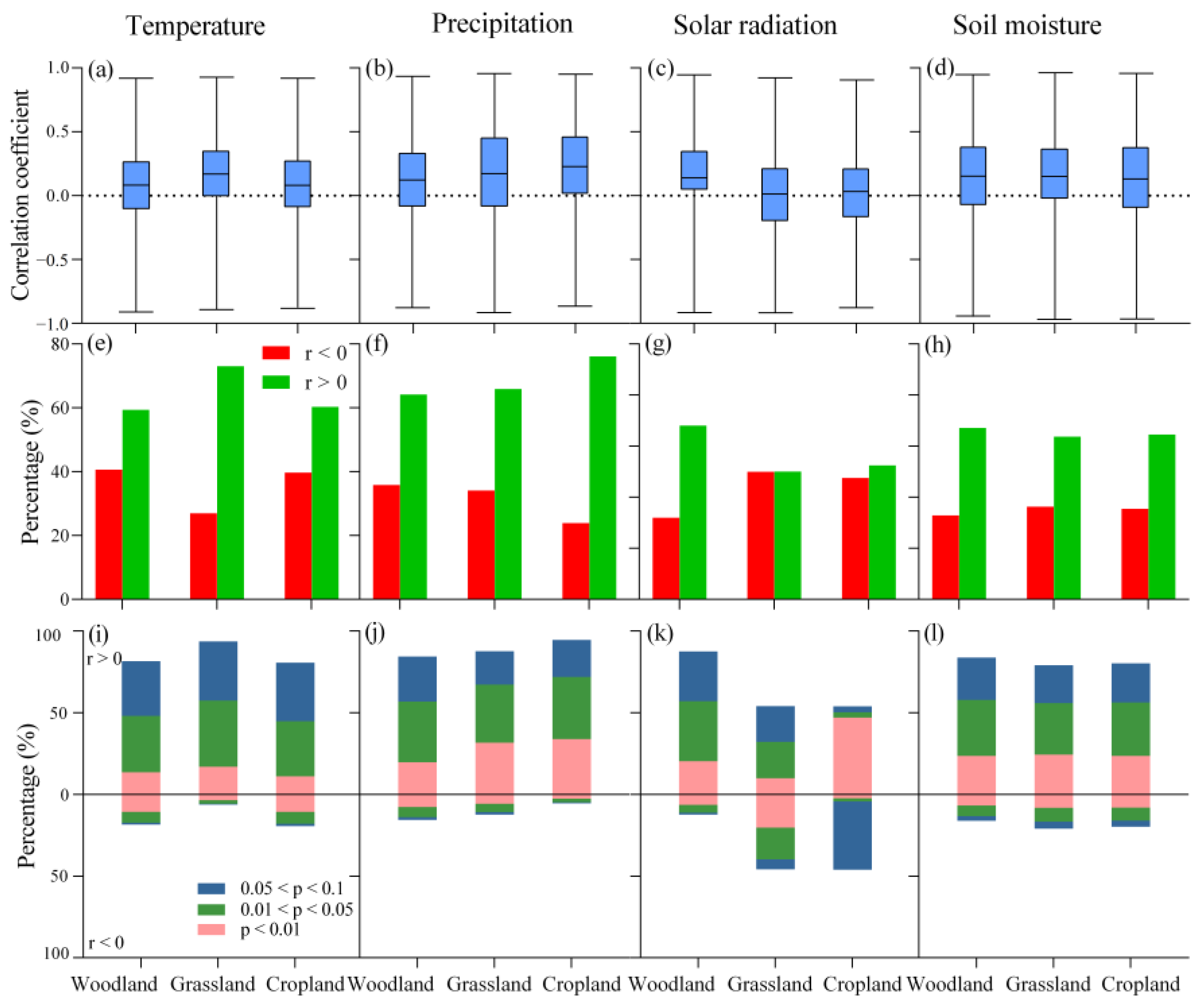
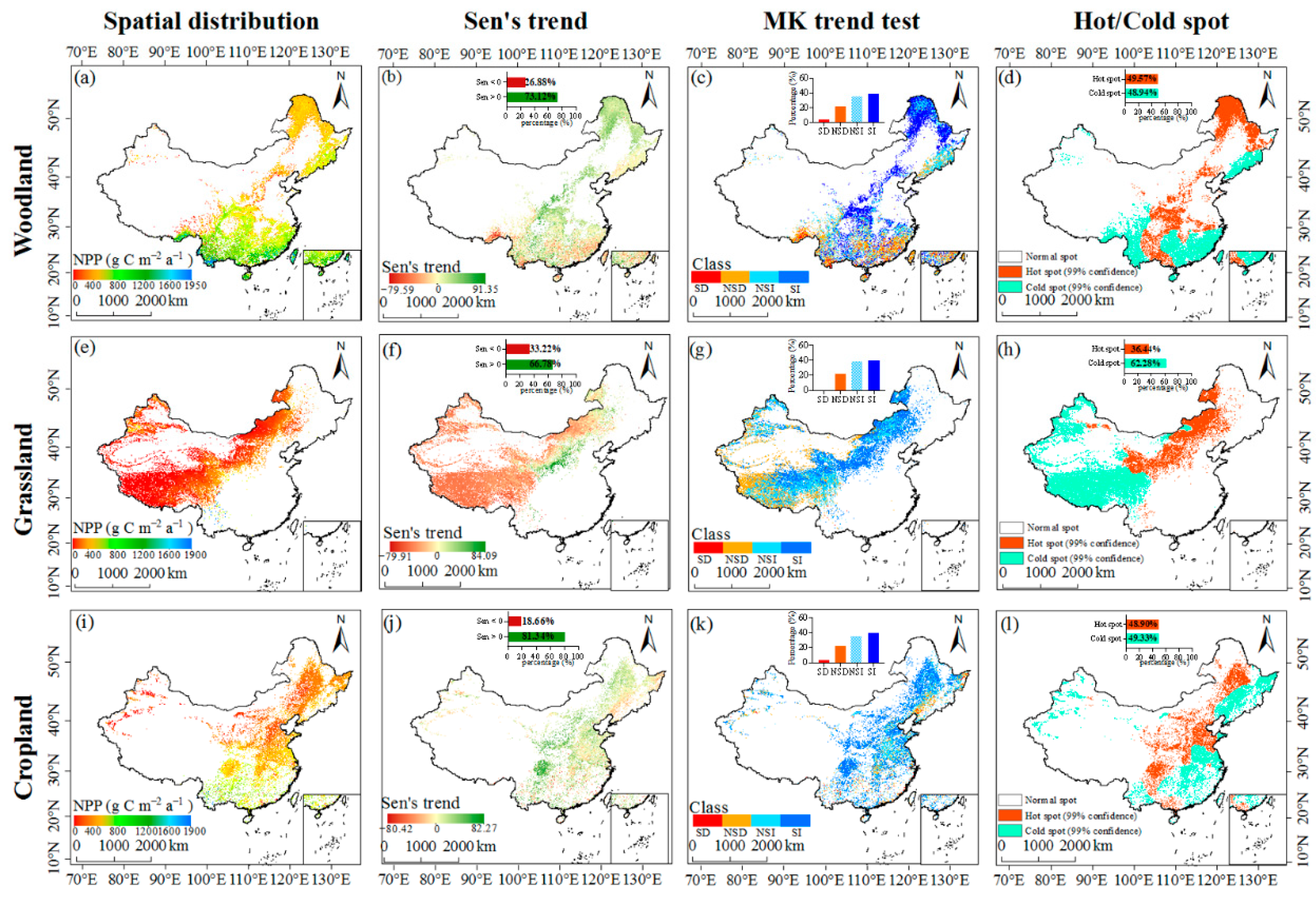
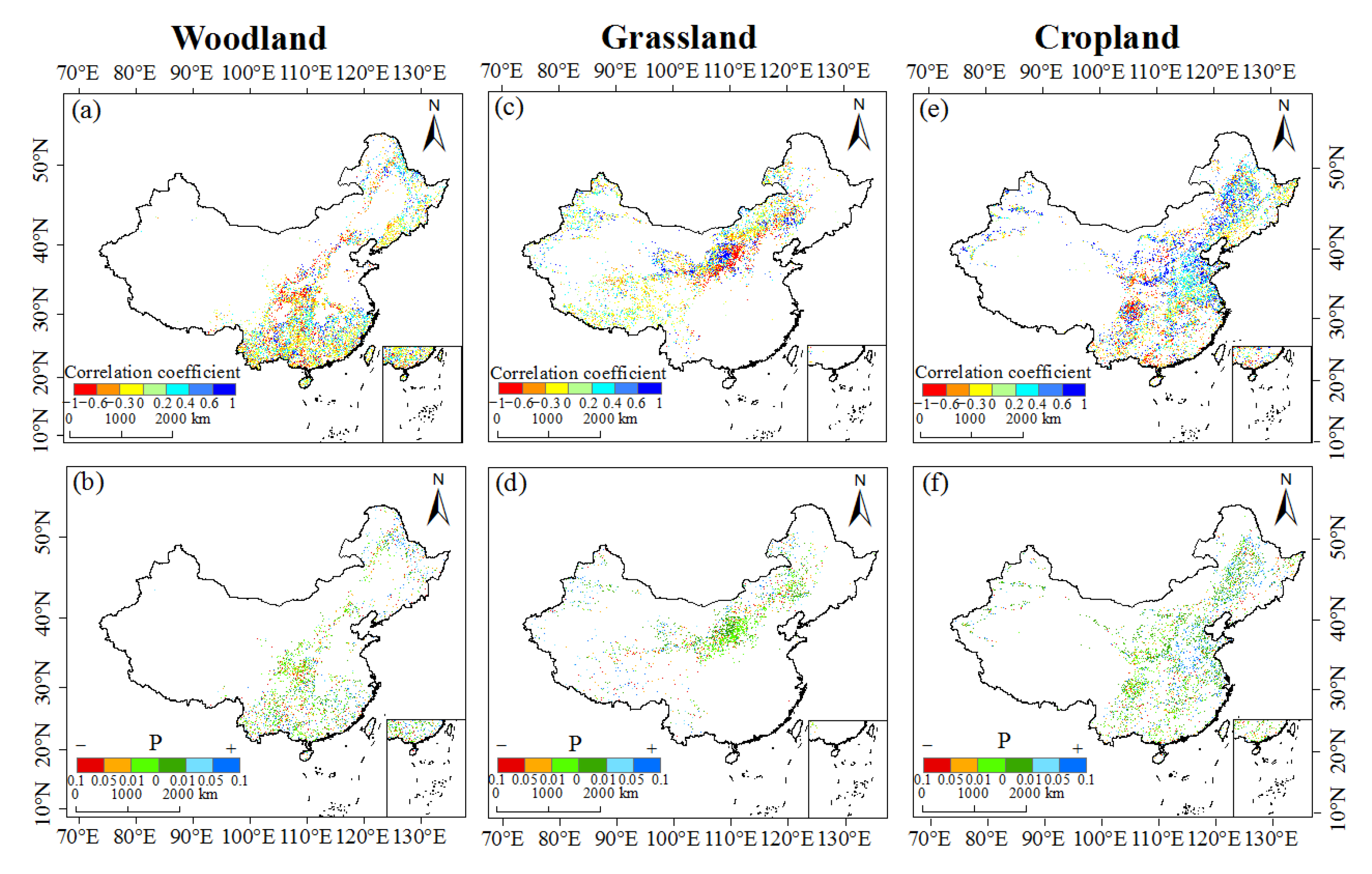
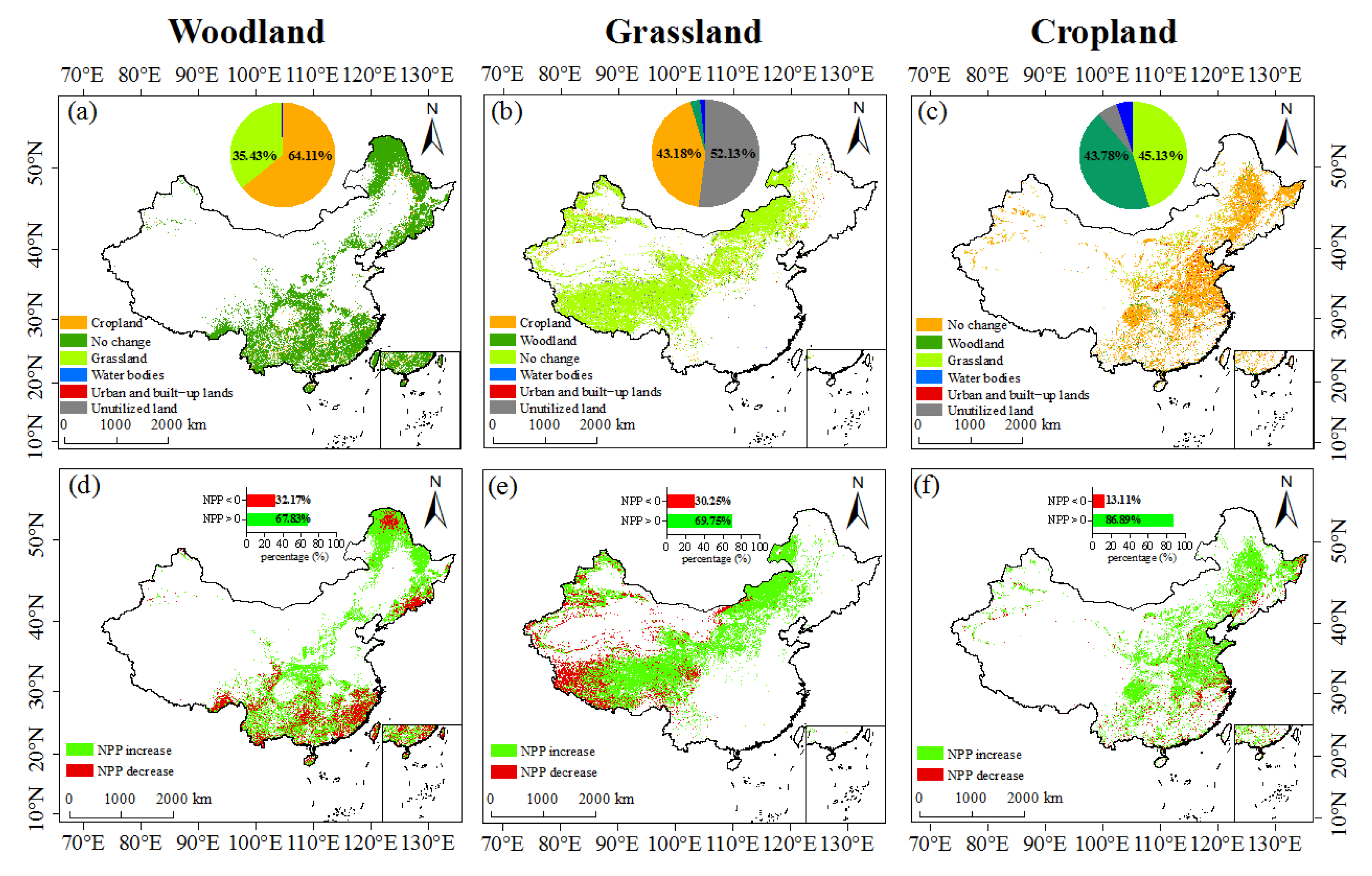

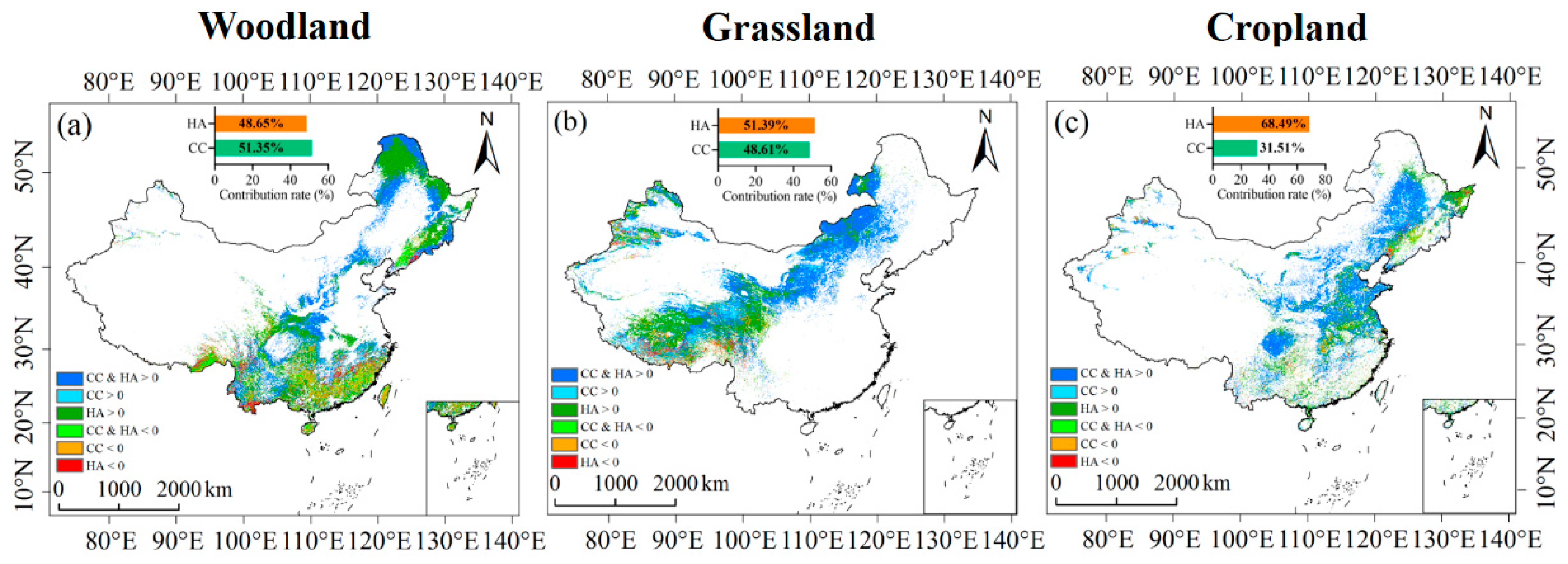
| CNPP | Driving Factors | Division Criteria of Driving Factors | Relative Contribution Rate (%) | ||
|---|---|---|---|---|---|
| CCC | CHA | CC | HA | ||
| >0 | CC and HA | >0 | >0 | ||
| CC | >0 | <0 | 100 | 0 | |
| HA | <0 | >0 | 0 | 100 | |
| <0 | CC and HA | <0 | <0 | ||
| CC | <0 | >0 | 100 | 0 | |
| HA | >0 | <0 | 0 | 100 | |
Disclaimer/Publisher’s Note: The statements, opinions and data contained in all publications are solely those of the individual author(s) and contributor(s) and not of MDPI and/or the editor(s). MDPI and/or the editor(s) disclaim responsibility for any injury to people or property resulting from any ideas, methods, instructions or products referred to in the content. |
© 2025 by the authors. Licensee MDPI, Basel, Switzerland. This article is an open access article distributed under the terms and conditions of the Creative Commons Attribution (CC BY) license (https://creativecommons.org/licenses/by/4.0/).
Share and Cite
Wang, Y.; Tong, X.; Li, J.; Yang, M.; Wang, Y. Impacts of Climate Change and Human Activities on Vegetation Productivity in China. Remote Sens. 2025, 17, 1724. https://doi.org/10.3390/rs17101724
Wang Y, Tong X, Li J, Yang M, Wang Y. Impacts of Climate Change and Human Activities on Vegetation Productivity in China. Remote Sensing. 2025; 17(10):1724. https://doi.org/10.3390/rs17101724
Chicago/Turabian StyleWang, Yating, Xiaojuan Tong, Jun Li, Mingxin Yang, and Yin Wang. 2025. "Impacts of Climate Change and Human Activities on Vegetation Productivity in China" Remote Sensing 17, no. 10: 1724. https://doi.org/10.3390/rs17101724
APA StyleWang, Y., Tong, X., Li, J., Yang, M., & Wang, Y. (2025). Impacts of Climate Change and Human Activities on Vegetation Productivity in China. Remote Sensing, 17(10), 1724. https://doi.org/10.3390/rs17101724





